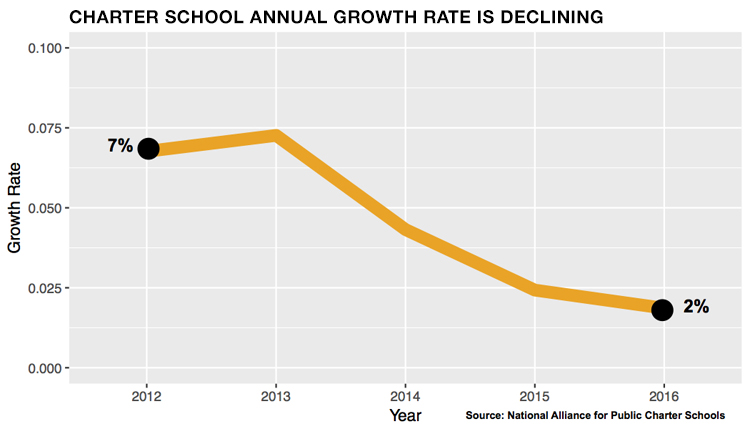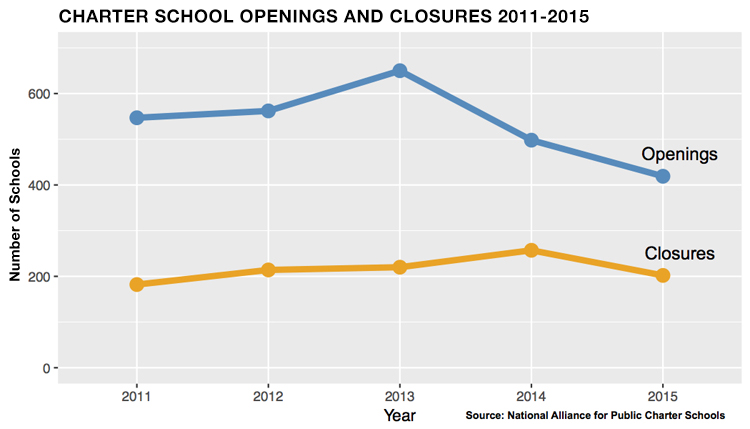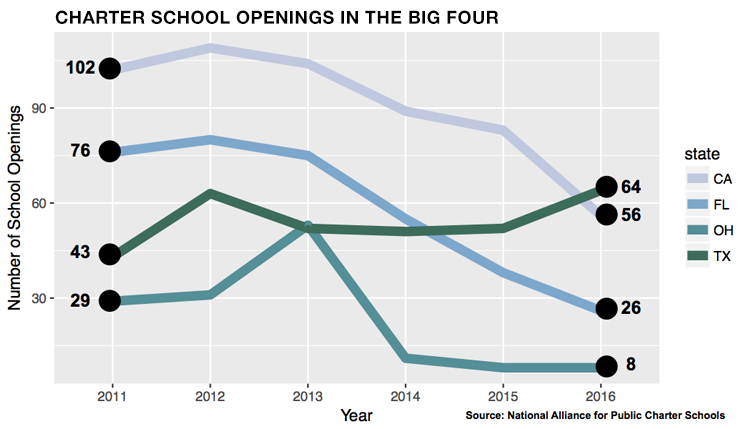A recently released annual update from the National Alliance for Public Charter Schools included a surprising fact: a mere 329 charter schools opened across the country in the 2016-2017 school year. In no year since the Alliance began tracking new charter openings has the total number of new schools been so low. Looking back at CRPE’s Hopes, Fears, and Reality series, it appears that it was the early 2000s when we last saw fewer than 350 new charter schools open. When you take closures into consideration, the total additional growth of charter schools last year was just over 100 schools, or nearly 2 percent.
Student enrollment numbers tell a different story. Total charter student enrollment surpassed 3 million this year, a 7 percent increase over last year. This likely reflects existing schools’ addition of grade levels and approach to full capacity.
So what’s behind this year’s meager school growth? Should charter advocates be worried? Of course, one year doesn’t prove a trend, but my colleague Mike DeArmond and I looked back five years and see that, in general, the rate of charter growth has pretty consistently held at 6 to 8 percent until the 2014-2015 school year, when the rate slowed to around 4 percent. In 2015-2016, it slowed further to just barely over 2 percent, and then down to the current 1.8 percent. This year is not an anomaly. So what is going on?
More aggressive closures don’t explain the slow down. The number of charter school closures over the last five years has held pretty steady. Last spring’s number of closures (202) is actually lower than the previous year’s high-water mark of 257. And if you look at the rates of closures and openings over the last 10 years, it’s clear that openings have slowed faster than closures have increased.
Political backlash? The most obvious explanation is politics. In states like Massachusetts, charters are coming up against caps and growing political opposition. Massachusetts only added one new charter this school year. Opposition has also dramatically increased as charters move from a sideshow to a more mainstream reform strategy in many cities. In cities with significant charter growth, local board, union, and community opposition can increase exponentially as districts deal with the financial reality of enrollment loss.
It’s very interesting to look at the Big Four states that have historically driven most charter growth: Texas, California, Ohio, and Florida. All, with the exception of Texas, have been producing fewer new charter schools for the past few years, while closure rates have held reasonably steady. Arizona and Michigan, two other significant charter growth states with pro-choice, no-cap state policies, added just a handful of new schools between them this year. All of this says to me that there is something going on besides just “big P” politics.
Ossification? I have a strong suspicion that the slowdown has a lot to do with the maturation of the movement: great teachers and school leaders are probably getting harder to come by, especially with the slowed growth of TFA. There are increased union efforts to unionize charters and some big CMOs have slowed their expansion efforts in order to focus on quality.
Slowing/uneven demand? Parents are still choosing charter schools and demand is high, but we are seeing that in some “high-choice” cities even high-performing charter schools are having a hard time attracting parents away from their default neighborhood school. Facilities options are also getting slimmer as charter schools grow and compete with one another for unused buildings. On the other hand, the National Alliance for Public Charter Schools surveys show strong unmet demand for charter schools, and the still-increasing student enrollment numbers confirm that demand is still strong, overall.
Increased bureaucracy? Another explanation is that the barriers to starting a new charter school have been increasing. We hear reports that charter authorizers are getting much choosier and often now expect applicants to have a facility secured before the application is approved. This weeds out less-prepared applicants but also makes it increasingly expensive for well-prepared applicants to start a school. It’s worth a look from the National Association of Charter School Authorizers and others to see if politics or overly risk-averse bureaucracy is at play here.
What’s clear, though, is that the charter movement really needs to rethink its dominant assumption that the only factor limiting growth is access to start-up funds. Continued growth will require much more authentic and sophisticated engagement in local and state politics. State laws that allow for continued growth of high-quality charters, and that give charters access to facilities, are crucial. Local charter school advocates also need to engage in assertive but respectful conversations about how to manage district enrollment loss so that students in district-run schools do not pay the price for unfettered growth. CRPE has some new proposals on this front coming soon.
Cooperative arrangements with districts, like those in Camden, NJ, and Indianapolis, will also have to be accelerated so that families who want to stay in their neighborhoods can still get the benefit of excellent charter schools, and charter schools can have a more stable enrollment base. Indianapolis, Philadelphia, and Camden are all great examples of how neighborhood-based charters can work. Citywide agreements over special education, expulsion, enrollment, and other issues are also critical foundations on which to build a stronger community political base.
Finally, states may need to take a look at the financial and other incentives embedded in their laws and policies. An economist might say that the supply of charter schools is simply meeting the logical limit of the current funding and political environment. If we want supply to change, we need to change that environment.
Things could start rebounding, but it seems to me that the days of easy, unfettered charter growth may be gone, at least for the near future. It’s time for honest conversations about what that means, especially given the demand and need for more high-quality choices. Clearly, asking funders to just keep bankrolling charter expansion is not enough.
—Robin J. Lake
Robin J. Lake is the director of the Center on Reinventing Public Education at the University of Washington.
This post originally appeared on The Lens.





